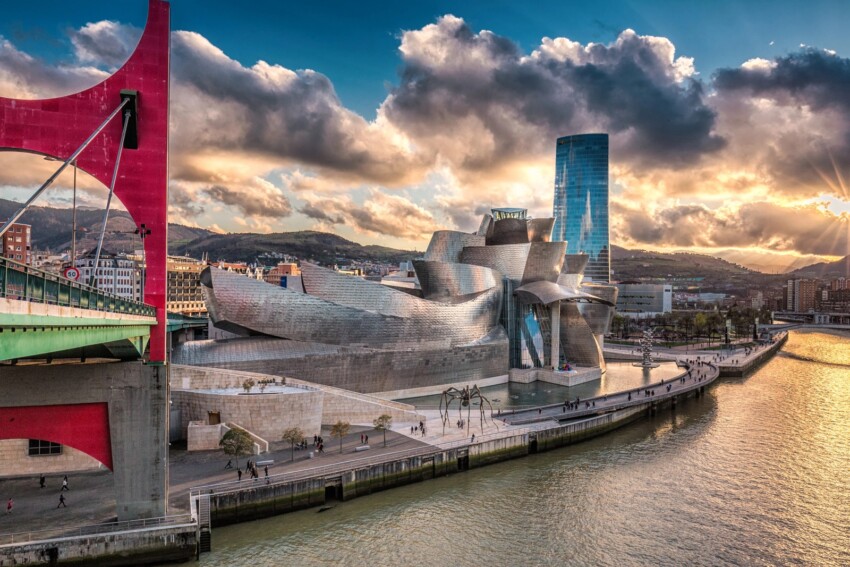
Guggenheim is the museum that changed the history of the city of Bilbao, taking it from post-industrial depression to a present of cultural ferment and enthusiasm.
The money spent on this titanic work was recovered in just four years and since then the Guggenheim Museum in Bilbao has been the city’s primary source of wealth: economic, but also social and moral. Indeed, it has become the symbol of a city that believed in its future and invested in a long-term project involving numerous local players.
A winning bet: the Guggenheim Bilbao is now one of the most visited museums in the world and has transformed the Basque city into a nerve centre of international creativity and a popular tourist destination.
To think that the announcement of the construction of an imposing contemporary art museum, the European headquarters of the prestigious Solomon R. Guggenheim Foundation of New York, on an old abandoned industrial district on the banks of the Nervión River was initially laughed at, considered as a joke in bad taste.
Today, the futuristic, gleaming titanium building designed by North American architect Frank Gehry is one of the architectural wonders of the world, exerting an irresistible charm on people of all ages and social backgrounds.
The Guggenheim Museum Bilbao is a place to be experienced: a full visit (entrance queues included!) requires at least half a day.
Start by observing the building from afar to admire the extraordinary construction as a whole and to be captivated by the spectacle of its walls that seem to change colour at different times of day. Up close you will notice surprising details that escape the overall view.
With the walk to the entrance, punctuated by works that have become pillars in the history of contemporary art, the museum experience is already at its climax. And you still have to enter!
Don’t hesitate to cross the threshold: our advice is to take your time and pay proper attention to the works on display, masterpieces that often get overshadowed by the fame of the iconic building.
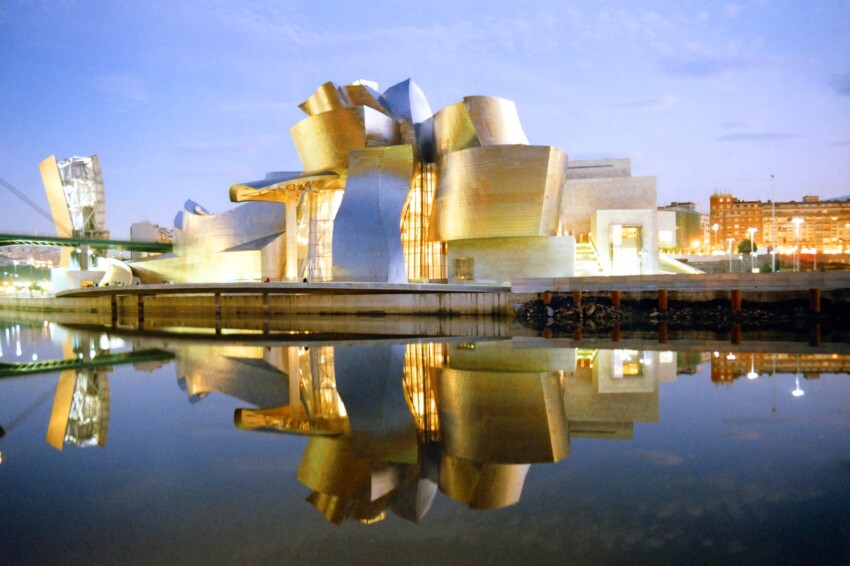
The deconstructivist-style building that houses the museum is the top attraction for most visitors. It takes the form of a huge sculpture made of titanium, limestone and glass whose shape reminds one of a flower, a ship or a decapitated fish without fins, depending on the observer’s point of view and imagination. It also reminds some people of a half artichoke! What everyone agrees on is the complexity of the construction and its extraordinary visual impact.
Gehry’s audacious design is not a bizarre abstraction, but an idea that takes the historical and geographical context of the city amply into account: in its form, the Guggenheim Museum’s headquarters clearly recalls Bilbao’s location on the ocean’s shores and the importance of the port and shipyards to its economy. The architect also drew on a personal childhood passion for fish.
The curved lines of its seemingly random exterior walls are designed to capture sunlight and react to natural light and weather conditions, creating fascinating optical effects. Lit by sunlight, the titanium tiles covering much of the building’s exterior surface resemble the scales of a golden fish.
Other features of the building’s exterior are intended to reproduce natural landscapes: for example, the main entrance is reminiscent of a river gorge.
Crossing the threshold of the entrance leads to the atrium, which is the heart of the building, the starting point of the visit and a reference point for all visitors. From here you access all the museum’s galleries, which are interconnected by a system of curved walkways, lifts and stairs. Due to its height, the atrium of the Guggenheim is reminiscent of a cathedral with a vast vault, flooded with natural light. The galleries are wide so that the work can be enjoyed in good condition even with a high influx of visitors.
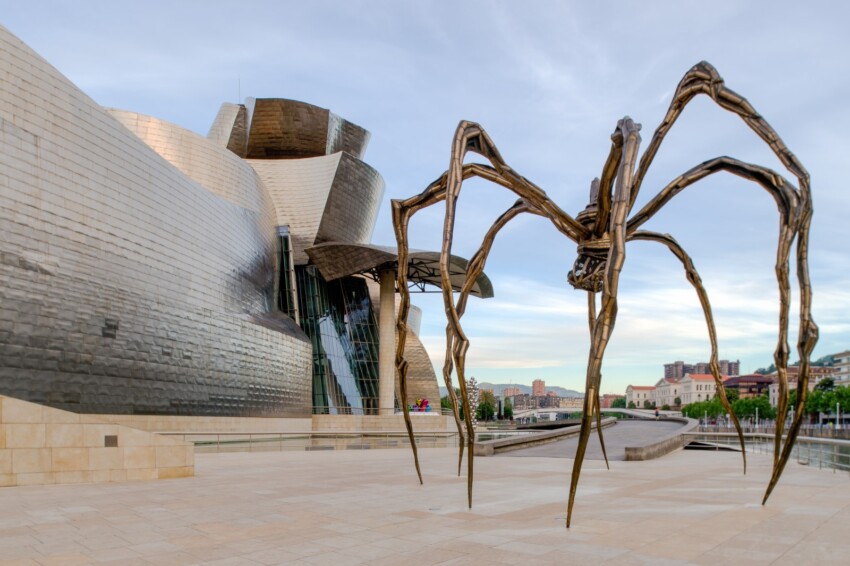
The space in front of the Guggenheim is an integral part of the museum: a true open-air exhibition space where you can admire some of the most famous installations and sculptures in the permanent collection.
The most famous sculpture is Louise Bourgoise’s iconic Maman, the giant spider made of bronze, marble and stainless steel supported by slender, threadlike legs that has become a symbol of Bilbao.
Standing a full 9 metres tall, it both frightens and amazes visitors about to enter the museum. The theme of the spider is recurrent in the artist’s career and symbolically represents the mother, a figure at once protector and predator, who despite her menacing appearance is highly vulnerable.
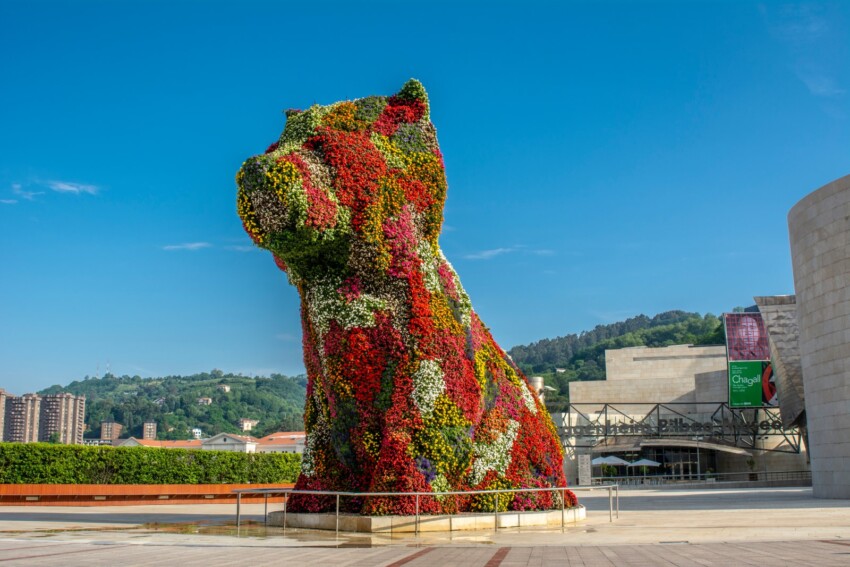
Another animal, this time a terrier puppy, is depicted in Puppy, a 12-metre high begonia sculpture by artist Jeff Koons. By the same artist is Tulips, a colourful bouquet of flowers of gigantic dimensions (more than two metres high) and garish metallic colours reminiscent of inflatable birthday party accessories.
Even the water pool in front of the museum entrance has become a work of art thanks to Fog Sculpture #08025: F.O.G, a fog sculpture by Japanese artist Fujiko Nakaya. The fog sculptures are composed of artificially created water droplets that remain suspended in the air: an artefact that is at the same time a natural phenomenon.
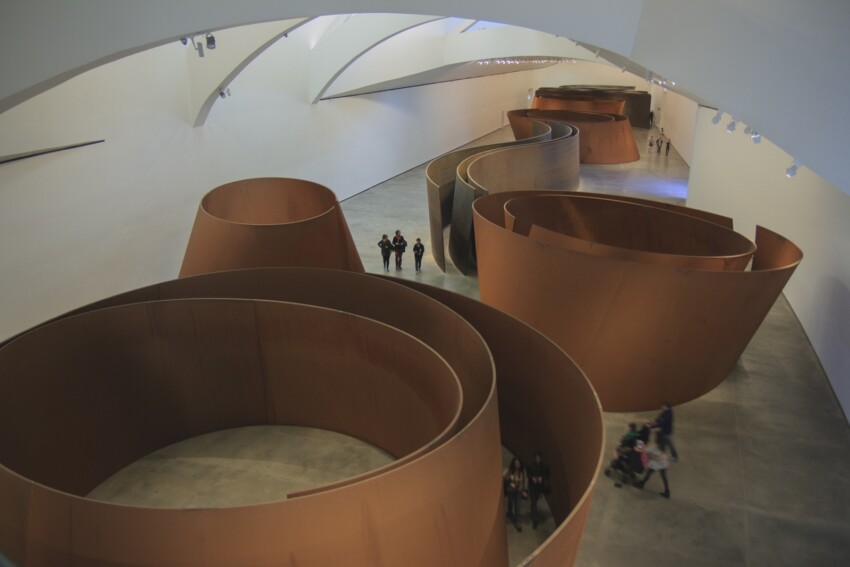
The fame of the building that houses the museum has completely overshadowed the exceptional collection on display inside. It is a paradoxical case of a museum where the container is more famous and appreciated than the content: try flipping through a couple of tourist guides and you will notice that they all devote many more lines to the building than to the museum’s works.
It is worth mentioning that the artistic direction of the museum is still entrusted to the Solomon R. Guggenheim Foundation, a name that is synonymous worldwide with contemporary art at the highest level. Both permanent and temporary exhibitions are of the highest quality, with attention to detail.
The permanent collection occupies the galleries on the ground floor and is a representative window on contemporary art from the second half of the 20th century to the present.
Highlights of the permanent collection include:
Temporary exhibitions offer a broader perspective on the art of our time and are often more popular than the permanent collection. They are considered must-see exhibitions for all art enthusiasts.
Entrance tickets to the Guggenheim Museum Bilbao can be purchased directly at the ticket offices, but since queues are always very long, it is advisable to buy them online at the museum’s official website. When purchasing, you must specify the day and time of your visit.
There is a discount for adults over the age of 65 and for students aged 13 to 26 (an international student card is required over the age of 18); children up to the age of 12 get in free.
Some tour operators offer tours with private visits to the Guggenheim Museum: they are much more expensive than the entrance fee alone, but they allow you to skip the queues and visit the Guggenheim in the company of an expert guide who will give you valuable information to better appreciate the architecture of the building and the artworks it holds. These tours can also be purchased online.
Inside the museum there are two restaurants, a library and a cloakroom, plus numerous services for accessibility. Bags and backpacks larger than 35 x 35 cm must be left in the cloakroom; luggage and objects larger than 61 x 47 cm are not accepted.
Free tours are organised daily and can be booked only half an hour before the start at the museum information point. Times and duration may vary, for more information see the official museum website.
A special event organised once a month is Art After Dark, evenings of art and music with DJ sets in the museum atrium from 10 p.m. to midnight. The museum also organises numerous activities for children, workshops, meetings and other cultural events.
The Guggenheim Museum is located at the northern end of Bilbao city centre and is easily accessible by public transport. Trams and subways have stops in the vicinity of the museum and services are quite frequent.
Those arriving by car should be aware that the museum has no parking facilities. There are, however, public and private car parks in the vicinity of the museum, unfortunately all for a fee.
If you are a fan of modern art and the Guggenheim is the main reason for your stay in Bilbao, you should definitely choose to sleep in its vicinity so that you can visit it first thing in the morning.
Fortunately, the choice is really wide: the avenue that surrounds the Guggenheim from the south, namely Mazarredo Zumarkalea, is really full of hotels, accommodation and flats for tourists. Among them stands out The Artist Grand Hotel of Art, a beautiful five-star hotel with splendid views of the futuristic museum skyline. Alternatively, if you are on a tighter budget, there are other hotels and flats in the immediate vicinity, so you can walk to the Guggenheim in just a few minutes.
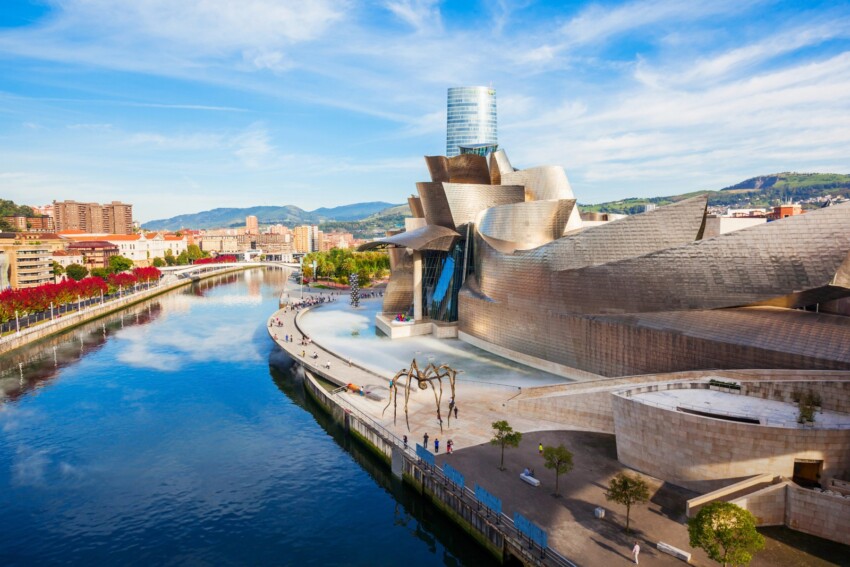
The history of the Guggenheim Museum in Bilbao begins in 1991: it was in this year that the local government and the Solomon R. Guggenheim Foundation negotiated to choose the Basque city as one of the international headquarters of the prestigious American institution.
Over the next two years, the area of the city on which to build the museum was identified and the project was entrusted to architect Frank O.Gehry. In February 1993, the first schematic drawing of the museum was presented; the following year, construction work began.
The museum was officially opened in October 1997; the inaugural celebrations lasted 15 days and involved nobles, politicians and celebrities.
The Guggenheim Bilbao opened its doors to the public on 19 October 1997. Already in the first year of its opening, the museum’s economic impact on the city far exceeds the forecasts that had convinced the Basque administration to invest huge sums of money, and the museum achieves major worldwide recognition.
From then on it was a continuous succession of awards, including in 2000 the European Museum Forum’s European Museum of the Year Award, in 2002 the Wonders of the Modern World Award from the Condé Nast travel and art publishing house and the Italian Touring Club’s Great Museums of Europe Award, and in 2010 the title of Best Building of the Last 30 Years according to Vanity Fair magazine.
The Guggenheim Museum is located in Bilbao, on the south bank of the Nervion River, east of the city's railway station and historic centre.